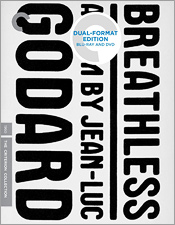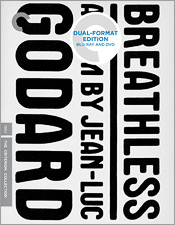Breathless (Blu-ray Review)

Director
Jean-Luc GodardRelease Date(s)
1960 (February 25, 2014)Studio(s)
Pretty Pictures (Criterion - Spine #408)- Film/Program Grade: A
- Video Grade: A
- Audio Grade: B-
- Extras Grade: A
Review
Anyone approaching Jean-Luc Godard’s Breathless for the first time in 2014 can be forgiven for having some trepidation. After all, the movie’s reputation precedes it by a country mile. Even the back cover of Criterion’s Dual-Format release declares, “There was before Breathless, and there was after Breathless.” If you’ve never seen it before, you may think of it as a Homework Movie. A Homework Movie is any movie that you don’t really want to see but feel like you probably should because it’s Important.
I hope I’m wrong about that and that new audiences still watch Breathless simply because they want to. Breathless is by far Godard’s most accessible movie. You don’t have to work too hard to be able to enjoy Breathless. It’s filled with the atmosphere and attitude of the late 50s and early 60s. It’s entertaining, it’s sexy, and it moves right along with a rhythm all its own. Of course, the harder you work at Breathless, the more it reveals itself to be one of the truly great films.
Jean-Paul Belmondo became an international superstar with his role as Michel Poiccard (a.k.a. Laszlo Kovacs), a small-time crook and habitual car thief. After he kills a cop, he flees to Paris to collect some money he’s owed. This proves difficult, so he reconnects with an American lover (Jean Seberg as Patricia Franchini), an aspiring journalist for the New York Herald Tribune. Michel and Patricia attempt to figure out exactly how they feel about each other while the police dragnet tightens around Michel.
At this point, it may be hard to recognize what made Breathless so groundbreaking in 1960, simply because so much of the film language it created has now been thoroughly integrated into the art of filmmaking. The roving hand-held camera, the jump cuts and quick editing, and the references to other movies and pop culture are now par for the course. But if you program a little chronological movie marathon and a handful of movies from previous decades and work your way up to Breathless, you’ll see that this movie looked like nothing else that came before it. It’s a testament to how skillfully Godard put the film together that this radical change was embraced and not rejected.
Even today, there are elements of Breathless that stand out as unique. Raoul Coutard’s cinematography is considerably more fluid and exact than we’re used to handheld camerawork being today. Coutard’s camera is another character in the film. We’re never racing to catch up with the actors and we’re never not sure where our eye is supposed to go. And it’s still startling when Belmondo and Seberg look directly into the camera. We’ve seen the fourth wall broken more often since then but when Belmondo turns to the camera and directly addresses us less than ten minutes into the picture, it’s a bold announcement that this movie is going to be different.
Criterion first released Breathless on DVD in 2007, then on Blu-ray in 2010. Those releases are now replaced by this Dual-Format edition that brings everybody together into one happy little package. The Blu-ray looks great. It’s a properly cinematic image with pleasing black levels and excellent detail. The clouds of cigarette smoke that seem to perennially follow Belmondo seem almost tactile. The uncompressed mono sound is fine, doing the best it can within the limitations of its source material.
The extras offer nothing that wasn’t already on the previous DVD and Blu-ray releases but since those were already excellent, nothing new is really needed. There are vintage interviews with Godard, Belmondo, Seberg and filmmaker Jean-Pierre Melville (one of several Godard colleagues who appear in Breathless) conducted for French TV between 1960 and 1964. There are 2007 interviews with cinematographer Coutard, assistant director Pierre Rissient and filmmaker D.A. Pennebaker on the influence of documentary filmmaking on Breathless. There is an excellent visual essay by Mark Rappaport on the tragic life of Jean Seberg and another, highly informative visual essay by Jonathan Rosenbaum called Breathless As Criticism. Godard’s 1959 short film Charlotte Et Son Jules, starring Belmondo, is also included, as is the famous French trailer for Breathless. The 80-minute documentary Chambre 12, Hotel Du Suede completes the package and it’s OK but slightly disappointing. There are some fine interviews but the movie’s attempts to replicate Breathless’ black-and-white look on videotape doesn’t really work and gets old pretty quickly.
In many ways, Godard has been trying to reinvent cinema with every movie he’s made since Breathless. Say this much for him, he hardly ever repeats himself. While I think he’s made better films since Breathless (and, it must be said, infinitely worse), it’s unlikely that any will ever have the same transformative effect. After all, how many people can put “changed cinema forever” on their resume?
- Adam Jahnke

